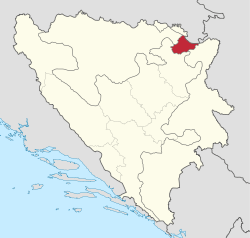Political divisions of Bosnia and Herzegovina
The political divisions of Bosnia and Herzegovina were created by the Dayton Agreement, which recognized a second tier of government in Bosnia and Herzegovina, comprising two entities: the Federation of Bosnia and Herzegovina (FBiH), with mostly Bosniaks and Croats, and the Republika Srpska (RS) with mostly Serbs – each governing roughly one half of the state's territory. The Federation of Bosnia and Herzegovina itself has a federal structure and consists of 10 autonomous cantons.
| Political divisions of Bosnia and Herzegovina Administrativna podjela Bosne i Hercegovine Административна подјела Босне и Херцеговине | |
|---|---|
.svg.png) Administrative divisions of Bosnia and Herzegovina: Republika Srpska entity (1), Federation of Bosnia and Herzegovina entity (2), Brčko District condominium (3) | |
| Category | Federated state |
| Location | |
| Created | 14 December 1995 |
| Number | 2 entities and 1 condominum |
| Populations | 83,560 (BD) – 2,219,220 (FBiH) |
| Areas | 493 Km² (BD) – 26,110.5 Km² (FBiH) |
Overview
The Federation and the Republika Srpska governments are charged with overseeing internal functions. Each has its own government, flag and coat of arms, president, parliament (FBiH) and assembly (RS), police force, customs, and postal system. The police sectors are overseen by the state-level ministry of safety affairs. Since 2005, Bosnia and Herzegovina has one set of Armed forces.
The Inter-Entity Boundary Line is not determined by natural geographical features of the country. It rather follows the military front-lines as they were at the end of the Bosnian War. On the ground, there is no active border between RS and FBiH, and one would generally not know the difference when crossing from one entity into another.
The city of Brčko in northeastern Bosnia is a seat of the Brčko District, a self-governing administrative unit; it is part of both the Federation and Republika Srpska. The district remains under international supervision.
The Federation is further divided into ten cantons, which are then subdivided into municipalities. Republika Srpska is divided directly into municipalities.
| Name | Area | Population | Ethnic groups | Munic. | Status | Map |
|---|---|---|---|---|---|---|
| Brčko District Brčko Distrikt Брчко Дистрикт |
493 km² | 83,516 | Bosniaks (42.36%) Serbs (34.58%) Croats (20.66%) |
N/A | Self-governing Condominium |
 |
| Federation of BiH Federacija BiH Федерација БиХ |
26,110.5 km² | 2,219,220 | Bosniaks (70,40%) Croats (22,44%) Serbs (2,55%) |
79 (including 16 cities) |
Federal Entity |  |
| Republika Srpska Република Српска Republika Srpska |
24,532.8 km² | 1,218,107 | Serbs (82.95%) Bosniaks (12.69%) Croats (2.27%) |
64 (including 8 cities) |
Federal Entity |  |
Amendments to the divisions
Overview
Some interest groups have come forth with proposals for rearranging the subdivisions of Bosnia and Herzegovina, saying the Dayton Agreement's framework is outdated. The Agreement was initially designed to effectively end the war in the nation, but critics argue that its organization of the country was not meant to be permanent. Some feel the divisions have made the present day bureaucracy of the country unwieldy.
In general the nation's Bosniak representatives want for the state to be centralized, eliminating the two entities. Republika Srpska representatives want to retain the two entities.
Some Serb political organizations assume that if Kosovo achieves independence, Republika Srpska will separate from Bosnia and Herzegovina, eventually joining Serbia. However, the Office of the High Representative has come out and specifically denied the prospect of any such territorial exchange. Representatives of the Bosnian Croats largely view the current situation as discriminatory, and seek either the abolition of entities and foundation of a decentralized governmental structure, or a third entity (such as the war-time Croatian Republic of Herceg-Bosna).
Constitutional reform
Dayton established a rotating presidency of three presidents elected by the country's Bosniaks, Croats and Serbs. While this has led to a sort of power-sharing among ethnic groups it has made government less stable, with a new president every eight months.
Dayton also established the position of High Representative. This UN position was given wide-ranging powers, including the ability to sack high-ranking members of government.
The treaty also solidified the existence of two separate war-time entities in the country: the Federation of Bosnia and Herzegovina and the Republika Srpska (later the internationally administered Brčko District was created).
New talks involving eight political parties representing the two entities began in April 2005 with the assistance of the United States Institute of Peace, and two non-governmental organizations, the Dayton Peace Accords Project and the Public International Law and Policy Group. The NGO-lead negotiations continued up to the tenth anniversary of the Accords on 21 November 2005 when the United States took over the process.[1][2] The United States expected a preliminary deal to be reached at this conference, but talks soon fell apart. Members of the presidency did agree to increase the powers of the prime minister and add two ministries to the central government, but this fell far short of expectations. A second round of talks held on January 17 also failed to produce any results.
A sticking point has been the creation of a unified presidency. This would favour the largest single ethnic group (the Bosniaks), but some guarantees have been made for the other groups to hold vice-presidency.
Also, the country's great decentralization dating from the war has created a large bureaucracy. Any reform would have to strengthen the powers of the federal government. This would strip powers from both the Federation and the Republika Srpska. However, this has met opposition from the government of the Republika Srpska, which notes that of the country's thirteen governments, eleven are in the Federation (ten cantonal governments and the Federation government). The other two are the Republika Srpska and state (BiH)-level government.
These reforms are key to Bosnia and Herzegovina fulfilling their obligations to the European Union's Stabilisation and Association Agreement.
The six ruling coalition parties announced on 2007-12-14 that talks would resume in January in Brussels, and that the two main Croat parties (Croatian Democratic Union of Bosnia and Herzegovina and Croatian Democratic Union 1990) had submitted proposals for a new federal structure to the other party leaders.[3]
The main parties agreed to reinvigorate constitutional reform efforts after the successful signing of the SAA.[4] New talks were set to begin following the municipal elections in October 2008, as Lajcak stated that preparation for EU accession was impossible under the current constitutional order.[5]
A plan to divide Bosnia into four entities instead of the two in existence was proposed on 27 January 2009, with further talks scheduled for 23 February 2009.[6]
References
- R. Bruce Hitchner, "From Dayton to Brussels: The Story Behind the Constitutional and Governmental Reform Process in Bosnia and Herzegovina." The Fletcher Forum of World Affairs, Winter 2006 Vol. 30.1, 125-136
- Don Hays and Jason Crosby, "From Dayton to Brussels," USIP, Special Report, October, 2006.
- "BiH leaders to resume constitutional reform talks next month in Brussels (SETimes.com)". setimes.com.
- "BiH ruling parties to continue constitutional reform talks after signing of SAA (SETimes.com)". setimes.com.
- "Lajcak, Dodik agree constitutional reform talks will begin after BiH's local elections (SETimes.com)". setimes.com.
- http://www.setimes.com/cocoon/setimes/xhtml/en_GB/features/setimes/features/2009/01/27/feature-01
Further reading
- Bahtić-Kunrath, Birgit (2011). "Of veto players and entity-voting: institutional gridlock in the Bosnian reform process". Nationalities Papers. 39 (6): 899–923. doi:10.1080/00905992.2011.614224. ISSN 0090-5992.
- Belloni, Roberto (2009). "Bosnia: Dayton is Dead! Long Live Dayton!". Nationalism and Ethnic Politics. 15 (3–4): 355–375. doi:10.1080/13537110903372367. ISSN 1353-7113.
- Bose, Sumantra (2005). "The Bosnian State a decade after Dayton". International Peacekeeping. 12 (3): 322–335. doi:10.1080/13533310500074028. ISSN 1353-3312.
- Cooley, Laurence (2013). "The European Union's approach to conflict resolution: Insights from the constitutional reform process in Bosnia and Herzegovina". Comparative European Politics. 11 (2): 172–200. doi:10.1057/cep.2012.21. ISSN 1472-4790.
- Hayden, Robert M. (2005). ""Democracy" without a Demos? The Bosnian Constitutional Experiment and the Intentional Construction of Nonfunctioning States". East European Politics and Societies: And Cultures. 19 (2): 226–259. doi:10.1177/0888325404272679. ISSN 0888-3254.
- Keil, Soeren; Kudlenko, Anastasiia (2015). "Bosnia and Herzegovina 20 Years after Dayton: Complexity Born of Paradoxes" (PDF). International Peacekeeping. 22 (5): 471–489. doi:10.1080/13533312.2015.1103651. ISSN 1353-3312.
- Perry, Valery (2015). "Constitutional Reform in Bosnia and Herzegovina: Does the Road to Confederation go through the EU?". International Peacekeeping. 22 (5): 490–510. doi:10.1080/13533312.2015.1100082. ISSN 1353-3312.
- Sebastian, Sofia (2009). "The Role of the EU in the Reform of Dayton in Bosnia-Herzegovina". Ethnopolitics. 8 (3–4): 341–354. doi:10.1080/17449050903086948. ISSN 1744-9057.
- Touquet, Heleen; Vermeersch, Peter (2008). "Bosnia and Herzegovina: Thinking Beyond Institution-Building". Nationalism and Ethnic Politics. 14 (2): 266–288. doi:10.1080/13537110801985120. ISSN 1353-7113.
